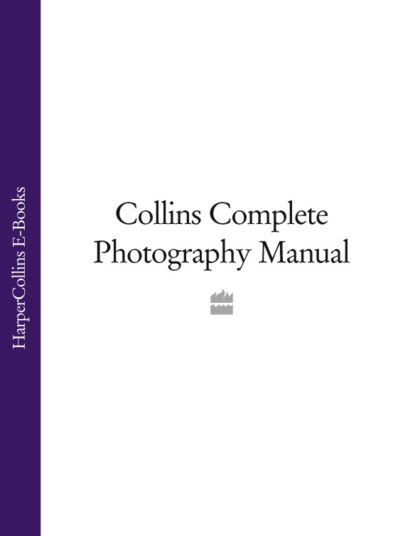По всем вопросам обращайтесь на: info@litportal.ru
(©) 2003-2024.
✖
Collins Complete Photography Manual
Автор
Год написания книги
2018
Настройки чтения
Размер шрифта
Высота строк
Поля
Collins Complete Photography Manual
Collins Dictionaries
Everything you need to know about photography, both digital and film, written by a team of experts. This comprehensive and superbly illustrated guide covers all aspects from basic composition to the latest digital know-how and digital darkroom techniques.Practical, inspiring and informative, Collins Complete Photography Manual takes you from choosing the right camera and understanding what different lenses can achieve, to creating the best possible composition. In addition, key techniques, such as image manipulation, are illustrated with stunning images and accompanied by easy-to-follow jargon-free text.There are separate sections on different themes, such as landscapes and nature, still life and sports shots, architecture, weddings, animals, and how to take a good portrait. In addition, professional tips throughout help you to avoid potential problems and show you how to get the best out of your camera and raise your level of photography.
Collins Complete Photography Manual
Everything you need to know about photography, both digital and film.
Table of Contents
Cover Page (#u07710268-319d-52b9-b882-4591b3e6c03a)
Title Page (#u700f9e3e-656a-551d-acdb-97851b6f8144)
Introduction (#u6b09e022-3cd7-5752-afb7-c54529e2125e)
chapter 1 Getting Into Photography (#u42d1a8df-1546-5a52-b72a-e804aa345512)
chapter 2 Lenses and Accessories (#u3ff8dc74-2833-59b2-a506-abbc666d8755)
chapter 3 Technicalities and Techniques (#litres_trial_promo)
chapter 4 Composition, Lighting and Colour (#litres_trial_promo)
chapter 5 Themes for Photography (#litres_trial_promo)
chapter 6 Advanced Photography (#litres_trial_promo)
chapter 7 Post-Production and Printing (#litres_trial_promo)
Glossary (#litres_trial_promo)
Index (#litres_trial_promo)
Acknowledgements (#litres_trial_promo)
Copyright (#litres_trial_promo)
About the Publisher (#litres_trial_promo)
Introduction (#ulink_40153db7-ea88-5a25-8cb7-6b0c0c944f0b)
Photography means different things to different people. For some it is a way of capturing memories – of having a lasting reminder of special moments. For others it is a way of expressing themselves artistically. For a fortunate few, it is a rewarding way of earning a living. But for many it is simply one of the most fascinating hobbies there is to be enjoyed – a delicious blend of art and science that can be practised on its own or combined with other pastimes.
Equipment matters
One of the secrets of success is choosing the right camera. Most of us now have one built into our mobile phone – and increasingly as digital resolution improves the quality of images produced is perfectly acceptable at relatively small degrees of enlargement. However, camera phones are extremely limited. While it is convenient to have them immediately to hand, so you can take pictures as and when the opportunity arises, they lackthe versatility of dedicated cameras.
For this reason, those who are serious about taking good pictures tend to spend as much as they can afford on equipment, rather than making do with what they have already. At the very least, you need a compact camera with a decent zoom lens, and ideally a Single Lens Reflex camera with a collection of interchangeable lenses and other accessories.
While you can tackle most popular subjects successfully with a compact camera, the tool of choice for serious photographers is an SLR, onto which you can fit everything from wide-angle lenses to open up perspective, and get more into the frame, to telephoto lenses that enable you to pull in distant subjects and compress perspective. Most also give more control over exposure, allowing you to control the shutter speed and aperture.
While some photographers still use film, the majority have now switched to digital. The advantages are obvious: the quality is fantastic, you can see your pictures immediately after you have taken them, and once you have bought the camera plus removable storage card – which can be used many times over – the running costs are minimal. Of course, you will need computer equipment to enjoy your photography to the full, but since most households now own a PC or Macintosh anyway, this is rarely a problem. Software to enhance images is bundled with most cameras or is readily available at a reasonable price. If you want prints to put in an album or frame, these can be ordered from photo labs at minimal cost, oryou might prefer to invest in an inkjet printer and produce them at home.
If you prefer using film, or have a significant investment in film cameras, one option is to continue shooting in the traditional way and either scan the negatives, transparencies or prints. This, however, can be extremely time-consuming, and since digital SLR bodies are now available that are compatible with most systems, it makes sense in most instances to make the transition to the latest technology.
This book assumes, therefore, that most readers are shooting digitally, and either using a compact camera with a zoom lens or an SLR with a range of lenses. In Chapter Two we consider in detail the opportunities offered by different lenses and lens settings, not only in terms of the subjects that can be taken successfully, but also with regard to the effects that can be produced. It is this variety and versatility that makes photography so endlessly fascinating. Adding a range of accessories, such as tripods and flashguns, increases your options yet further.
Developing your technique
Equipment, though, will only take you so far. Ultimately it is developing your technique that will determine how good your pictures are. And that comes to down to a number of key photographic skills: control over exposure; accurate focusing; effective composition; and powerful use of lighting.
Once you have mastered the different exposure ‘modes’ you will be able to put the right amount of light on the sensor or film in your camera in the most creative way – varying the shutter speed and aperture according to what you are seeking to express. You will also learn to recognize the kinds of situations in which exposure meters are most likely to be misled and get things wrong – and then what you can do about it.
Focusing, too, can sometimes be tricky. It is fair to say that modern, advanced focusing systems work well most of the time; however, if you are not careful, they will sometimes focus on the wrong part of the subject. Consequently, you need to know when to override automatic operation in your camera and take control yourself.
Effective composition is at the heart of successful photography. Faced with a particular subject, there are dozens of different ways in which the elements could be arranged in the frame. Of course, much of this is down to personal taste and choice – after all, it’s your picture! However, if you follow a few simple rules – such as using frames, dynamic diagonals and lead-in lines – your picture-taking will improve immeasurably. Colour, too, is crucial, and the way you blend tones can make or break an image.
As you become a more experienced photographer, you will also need to learn how to make the most of the many moods and nuances of daylight. Once you understand how light changes from dawn to dusk, from season to season, and according to the weather, you will be able to match the right light to the right subject. Quality of light is more important than quantity of light, and some of the best pictures are taken when ambient levels are low or at night. This requires excellent technique to avoid problems with camera-shake and exposure.
Developing an eye for a picture
Ultimately, becoming a good photographer is a matter of learning to make pictures rather than just take them. No matter what subject you like to shoot, you should always be looking for ways of improving what you find already there, not just accepting things as they are. Follow the advice given in Chapter Four: exploring original and eye-catching ways of capturing your subject will help your images stand out from the crowd.
The most popular subjects for photography are people, landscapes, children, architecture and travel, and in Chapter Five we explore them fully, along with other subjects including sport and action, pets, close-ups, documentary and nude. As you learn specific techniques that are particularly effective in each area, so you will produce even better pictures.
For those who would like to go further, in Chapter Six we examine the challenges of taking pictures in the studio, and consider ways of making money from photography – perhaps even the potential for going freelance or turning professional.
Enhance and manipulate
Capturing your subject, though, is only the beginning. Once you have transferred the image to your computer a whole world of creativity opens up. You can improve colour, exposure and composition, or selectively lighten and darken specific areas. Unwanted elements can be completely removed. Images can be combined, filters added to creative effect, pictures transformed into black and white or toned. All these options are explored in Chapter Seven to get your creative juices flowing.
Looking forward
Photography has been in existence for over 160 years, and it is still as exciting and as interesting as it ever was. Collins Complete Photography Manual has been designed so that you can either read it from the front to the back or dip into each of the sections as you prefer – to find the information you need to become a better photographer.
We have sought not only to give you clear, practical advice but also to include inspirational, powerful pictures as a spur to your creativity.
Enjoy your photography!
chapter 1 Getting Into Photography (#ulink_99d65132-2eb4-5698-92a8-5883c4553d90)
Everybody takes pictures-and virtually everyone now shoots digitally. The medium offers many advantages, and it is easy to see why digital has replaced film. For a start you can viewyour pictures immediately, which means that you can check you have captured exactly what you wanted before moving on. Digital images are also tremendously accessible when you transfer them from the camera. You can view them straight away on a computer or television, and then print them out on your own inkjet or at one of the many instant print outlets. Best of all, once you have your digital camera and removable card, taking pictures is more or less free.
The Changing Nature of Photography
These days, getting started in photography generally means getting started in digital photography. Although film dominated the medium for decades and digital imaging is a quite recent phenomenon, relatively few people now buy or use film cameras.
The early days of photography
Collins Dictionaries
Everything you need to know about photography, both digital and film, written by a team of experts. This comprehensive and superbly illustrated guide covers all aspects from basic composition to the latest digital know-how and digital darkroom techniques.Practical, inspiring and informative, Collins Complete Photography Manual takes you from choosing the right camera and understanding what different lenses can achieve, to creating the best possible composition. In addition, key techniques, such as image manipulation, are illustrated with stunning images and accompanied by easy-to-follow jargon-free text.There are separate sections on different themes, such as landscapes and nature, still life and sports shots, architecture, weddings, animals, and how to take a good portrait. In addition, professional tips throughout help you to avoid potential problems and show you how to get the best out of your camera and raise your level of photography.
Collins Complete Photography Manual
Everything you need to know about photography, both digital and film.
Table of Contents
Cover Page (#u07710268-319d-52b9-b882-4591b3e6c03a)
Title Page (#u700f9e3e-656a-551d-acdb-97851b6f8144)
Introduction (#u6b09e022-3cd7-5752-afb7-c54529e2125e)
chapter 1 Getting Into Photography (#u42d1a8df-1546-5a52-b72a-e804aa345512)
chapter 2 Lenses and Accessories (#u3ff8dc74-2833-59b2-a506-abbc666d8755)
chapter 3 Technicalities and Techniques (#litres_trial_promo)
chapter 4 Composition, Lighting and Colour (#litres_trial_promo)
chapter 5 Themes for Photography (#litres_trial_promo)
chapter 6 Advanced Photography (#litres_trial_promo)
chapter 7 Post-Production and Printing (#litres_trial_promo)
Glossary (#litres_trial_promo)
Index (#litres_trial_promo)
Acknowledgements (#litres_trial_promo)
Copyright (#litres_trial_promo)
About the Publisher (#litres_trial_promo)
Introduction (#ulink_40153db7-ea88-5a25-8cb7-6b0c0c944f0b)
Photography means different things to different people. For some it is a way of capturing memories – of having a lasting reminder of special moments. For others it is a way of expressing themselves artistically. For a fortunate few, it is a rewarding way of earning a living. But for many it is simply one of the most fascinating hobbies there is to be enjoyed – a delicious blend of art and science that can be practised on its own or combined with other pastimes.
Equipment matters
One of the secrets of success is choosing the right camera. Most of us now have one built into our mobile phone – and increasingly as digital resolution improves the quality of images produced is perfectly acceptable at relatively small degrees of enlargement. However, camera phones are extremely limited. While it is convenient to have them immediately to hand, so you can take pictures as and when the opportunity arises, they lackthe versatility of dedicated cameras.
For this reason, those who are serious about taking good pictures tend to spend as much as they can afford on equipment, rather than making do with what they have already. At the very least, you need a compact camera with a decent zoom lens, and ideally a Single Lens Reflex camera with a collection of interchangeable lenses and other accessories.
While you can tackle most popular subjects successfully with a compact camera, the tool of choice for serious photographers is an SLR, onto which you can fit everything from wide-angle lenses to open up perspective, and get more into the frame, to telephoto lenses that enable you to pull in distant subjects and compress perspective. Most also give more control over exposure, allowing you to control the shutter speed and aperture.
While some photographers still use film, the majority have now switched to digital. The advantages are obvious: the quality is fantastic, you can see your pictures immediately after you have taken them, and once you have bought the camera plus removable storage card – which can be used many times over – the running costs are minimal. Of course, you will need computer equipment to enjoy your photography to the full, but since most households now own a PC or Macintosh anyway, this is rarely a problem. Software to enhance images is bundled with most cameras or is readily available at a reasonable price. If you want prints to put in an album or frame, these can be ordered from photo labs at minimal cost, oryou might prefer to invest in an inkjet printer and produce them at home.
If you prefer using film, or have a significant investment in film cameras, one option is to continue shooting in the traditional way and either scan the negatives, transparencies or prints. This, however, can be extremely time-consuming, and since digital SLR bodies are now available that are compatible with most systems, it makes sense in most instances to make the transition to the latest technology.
This book assumes, therefore, that most readers are shooting digitally, and either using a compact camera with a zoom lens or an SLR with a range of lenses. In Chapter Two we consider in detail the opportunities offered by different lenses and lens settings, not only in terms of the subjects that can be taken successfully, but also with regard to the effects that can be produced. It is this variety and versatility that makes photography so endlessly fascinating. Adding a range of accessories, such as tripods and flashguns, increases your options yet further.
Developing your technique
Equipment, though, will only take you so far. Ultimately it is developing your technique that will determine how good your pictures are. And that comes to down to a number of key photographic skills: control over exposure; accurate focusing; effective composition; and powerful use of lighting.
Once you have mastered the different exposure ‘modes’ you will be able to put the right amount of light on the sensor or film in your camera in the most creative way – varying the shutter speed and aperture according to what you are seeking to express. You will also learn to recognize the kinds of situations in which exposure meters are most likely to be misled and get things wrong – and then what you can do about it.
Focusing, too, can sometimes be tricky. It is fair to say that modern, advanced focusing systems work well most of the time; however, if you are not careful, they will sometimes focus on the wrong part of the subject. Consequently, you need to know when to override automatic operation in your camera and take control yourself.
Effective composition is at the heart of successful photography. Faced with a particular subject, there are dozens of different ways in which the elements could be arranged in the frame. Of course, much of this is down to personal taste and choice – after all, it’s your picture! However, if you follow a few simple rules – such as using frames, dynamic diagonals and lead-in lines – your picture-taking will improve immeasurably. Colour, too, is crucial, and the way you blend tones can make or break an image.
As you become a more experienced photographer, you will also need to learn how to make the most of the many moods and nuances of daylight. Once you understand how light changes from dawn to dusk, from season to season, and according to the weather, you will be able to match the right light to the right subject. Quality of light is more important than quantity of light, and some of the best pictures are taken when ambient levels are low or at night. This requires excellent technique to avoid problems with camera-shake and exposure.
Developing an eye for a picture
Ultimately, becoming a good photographer is a matter of learning to make pictures rather than just take them. No matter what subject you like to shoot, you should always be looking for ways of improving what you find already there, not just accepting things as they are. Follow the advice given in Chapter Four: exploring original and eye-catching ways of capturing your subject will help your images stand out from the crowd.
The most popular subjects for photography are people, landscapes, children, architecture and travel, and in Chapter Five we explore them fully, along with other subjects including sport and action, pets, close-ups, documentary and nude. As you learn specific techniques that are particularly effective in each area, so you will produce even better pictures.
For those who would like to go further, in Chapter Six we examine the challenges of taking pictures in the studio, and consider ways of making money from photography – perhaps even the potential for going freelance or turning professional.
Enhance and manipulate
Capturing your subject, though, is only the beginning. Once you have transferred the image to your computer a whole world of creativity opens up. You can improve colour, exposure and composition, or selectively lighten and darken specific areas. Unwanted elements can be completely removed. Images can be combined, filters added to creative effect, pictures transformed into black and white or toned. All these options are explored in Chapter Seven to get your creative juices flowing.
Looking forward
Photography has been in existence for over 160 years, and it is still as exciting and as interesting as it ever was. Collins Complete Photography Manual has been designed so that you can either read it from the front to the back or dip into each of the sections as you prefer – to find the information you need to become a better photographer.
We have sought not only to give you clear, practical advice but also to include inspirational, powerful pictures as a spur to your creativity.
Enjoy your photography!
chapter 1 Getting Into Photography (#ulink_99d65132-2eb4-5698-92a8-5883c4553d90)
Everybody takes pictures-and virtually everyone now shoots digitally. The medium offers many advantages, and it is easy to see why digital has replaced film. For a start you can viewyour pictures immediately, which means that you can check you have captured exactly what you wanted before moving on. Digital images are also tremendously accessible when you transfer them from the camera. You can view them straight away on a computer or television, and then print them out on your own inkjet or at one of the many instant print outlets. Best of all, once you have your digital camera and removable card, taking pictures is more or less free.
The Changing Nature of Photography
These days, getting started in photography generally means getting started in digital photography. Although film dominated the medium for decades and digital imaging is a quite recent phenomenon, relatively few people now buy or use film cameras.
The early days of photography











